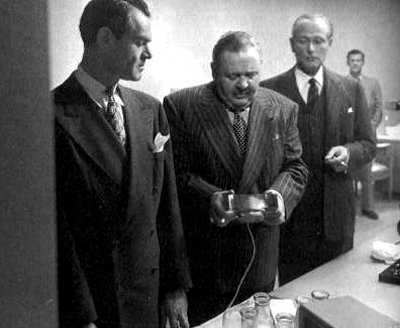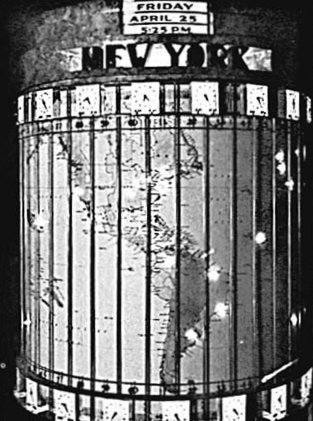 Superman Returns (2006) is effrontery to everything quality cinema stands for. It satisfies all of Hollywood’s blockbuster criteria to a T, and it had the audience in my screening cheering. But my honest, gut reaction was boredom: I engaged in none of their thrills, none of their excitement and shared none of their enthusiasm. I am speaking against the crowd not as a curmudgeon-before-his-time, but as an audience member who has seen almost all of what Superman Returns has to offer before, and pessimistically wishes never to see it again.
Superman Returns (2006) is effrontery to everything quality cinema stands for. It satisfies all of Hollywood’s blockbuster criteria to a T, and it had the audience in my screening cheering. But my honest, gut reaction was boredom: I engaged in none of their thrills, none of their excitement and shared none of their enthusiasm. I am speaking against the crowd not as a curmudgeon-before-his-time, but as an audience member who has seen almost all of what Superman Returns has to offer before, and pessimistically wishes never to see it again. Picking up somewhere in the middle of the Superman series, the movie opens with Superman (Brandon Routh) returning to Earth after several years of absence. Old flame Lois Lane (Kate Boswoth) is now in love with Richard White (James Marsen) and has a child, Jason White (Tristan Lake Leabu). Lex Luther (Kevin Spacey) has a plan to form a new continent out of crystals, drown North America, and defeat Superman. The outcome—he’s not called Superman for nothing.
Plot-wise, Superman Returns is a variation on a classic theme: guy wants girl, but a bunch of other guys keep getting in the way. The faults lie not in the basic structure, but in the details specific to the film. Most importantly, the film’s logic does not hold up to scrutiny. For example, if Kryptonite cripples Superman’s powers, then why doesn’t he drown after several minutes of being underwater? Too, if Lex Luther’s island is made of Kryptonite, then why is Superman able to carry it into space—shouldn’t he be powerless? These are only two of many questions that weren’t answered sufficiently during the film’s 154 minutes.
The script, written by Michael Dougherty and Dan Harris, is simply excessive (a facet that is, after all, inherent to all areas of multi-million dollar, superhero blockbusters). In terms of dialogue, it is both unnatural and unnecessary. For example: the scene in which Superman is drowning in the ocean and is saved by Lois Lane, David and Jason, needs no words. The dialogue is merely eventful, with phrases like “He’s over there!” and “I see him” as the trio flies their seaplane over the drowning hero. All of this: not needed. It could easily be accomplished with a cut from Lois and David looking out the window to Superman in the water; or—there are many ways, none of which require dialogue. At the moment, such pointless words serve only as vessels of bad acting. Instances such as this abound in Superman Returns, and the title of an article by the great German filmmaker F.W. Murnau, written at the end of the era of silent films, comes to mind: “The Ideal Picture Needs No Titles.” Transposed to modern times, it would read, “The Ideal Pictures Needs No Dialogue.” Or—at least “less” dialogue.
The film’s look—the cinematography, the directing, and the special effects—is so stunning that it has stunted its growth. Its beauty—which would otherwise be in quotes except that the movie does possess a glossy, artificial allure akin to Botox, facelifts and such—is sterile and cold. There is not a grain of physicality in the landscape: the buildings, even when on the verge of collapse during an earthquake, are not frightening. Partly the reason they are not so imposing is that we know Superman will be by to save the day. Largely, however, the reason is that the terrain lacks any intimacy: the danger is too aestheticized to feel real. What Superman Returns lacks is the simplicity of something like Vittorio De Seta’s Bandits of Orgosolo (1961), a film whose cinematic look resounds in physical imposition and destitution. De Seta (who also photographed the film) illustrates an intimacy with Sicily’s mountainous terrain that cannot be faked, and its authenticity cannot be completely explained in words (in which case it could be easily copied). Physicality is the key, and realism plays a big role, as well: when the shepherds carry injured sheep on their backs across the mountains, the weight on their shoulders and the rocks jutting through their soles is communicated to the audience, but I still have no physical empathy with the pedestrians of Superman Returns, nor with Superman himself. Superman Returns is a fantasy, whereas Bandits of Orgosolo embraces documentary realism—but perhaps the genres are not so disparate, after all, Superman Returns director Bryan Singer could learn a lot from Vittorio De Seta.
I began this review by acknowledging that I am disagreeing with the majority audience I saw the film with. I’m perturbed by the existing dichotomy between critics and audiences, as though they are somehow separate. Critics are audience members, and the audience is a pool of critics. The separation is none. A critic may not speak for an entire audience, but neither does the critic speak for all critics. As regards Superman Returns, I was bored and unexcited. It was obvious what to expect: you could see it coming from a mile away and, after all, it is a Superman movie—of course he is going to save the day. Is there any other outcome that could be expected? Superman has too many strengths and not enough weaknesses for me to hold my breath for long enough to swallow any of it.













